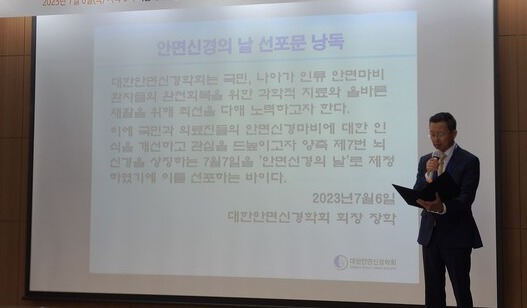When facial nerve paralysis, called “guanwasa” in oriental medicine, occurs, high-dose steroid treatment within 48 hours is a prerequisite to achieving full recovery in more than 80 percent of cases, an expert pointed out.
When palsy occurs on the face, most people think of oriental medicine. However, in the case of Bell's palsy, the most common type of facial paralysis, it is related to viral infections. So it is necessary to seek treatment from otolaryngology and other specialties, not oriental medicine, for accurate diagnosis and appropriate treatment in the early stages, the expert added.
“According to statistics at the Health Insurance Review and Assessment Service (HIRA), about 100,000 people are hit by facial paralysis every year, and the cause is not the cold wind or stroke as we have vaguely thought,” Professor Kim Jin-soo of the Department of Otolaryngology at Hallym University Dongtan Sacred Heart Hospital at a public forum held by the Korean Facial Nerve Society on Thursday.

Facial paralysis can be roughly divided into peripheral and central. But in the case of the most common peripheral type (Bell's palsy), which is caused by a viral infection, degeneration occurs after 48 hours, it is important to take high-dose steroids before degeneration occurs, Kim explained.
According to Professor Kim, 67 percent of facial paralysis is caused by herpes zoster virus or herpes simplex virus and perioral herpes zoster, also known as Ramsay Hunt syndrome. Among the rest, 13 percent is caused by head trauma, including around the ear, 10 percent is caused by tumors or inflammation of the ear or salivary glands, and less than 10 percent is caused by congenital, iatrogenic, or central facial paralysis.
"Facial paralysis is characterized by different specialties, depending on the timing of treatment. It is reasonable to treat the cause in the ENT department in the early stages and then refer to plastic surgery or rehabilitation department for facial reconstruction when it becomes chronic," Kim advised.
Professor Han Jae-sang of the Otolaryngology Department at the Catholic University of Korea Seoul St. Mary's Hospital agreed.
"The longer you wait to start medication, the more permanent damage will occur on your face, gradually lowering the chances of full recovery," Professor Han said. "A recent study showed that if you start steroid treatment within 48 hours, the six-month full recovery rate is about 80 percent. But if you start treatment more than 72 hours later, the rate drops to 60 percent. Therefore, 48 hours is the golden time to increase the full recovery rate."
Regarding facial paralysis, 64.7 percent of patients use oriental medical institutions. However, some of the diagnostic and treatment processes practiced by oriental medicine lack sufficient evidence, another expert pointed out.
"Facial paralysis is a typical disease with a high demand for duplicated medical care where Western and oriental medicine is sharply divided," said Professor Jeon Beom-jo of the Department of Otolaryngology at the Catholic University of Korea Uijeongbu St. Mary's Hospital. "However, from a medical point of view, some of the diagnostic and treatment processes practiced in oriental medicine are not based on sufficient evidence and may cause harm to some patients, so caution is needed."
After conducting an academic review of the “Standard Clinical Practice Guidelines of Traditional Chinese Medicine (TCM) for Facial Nerve Palsy,” many items in the guideline were given a recommendation grade of “C,” which means the benefit is unreliable. Still, Professor Jeon said it could be considered for use because of its high or moderate utilization in the clinic. In the end, one can interpret that it is used in the oriental clinic because it has long been in use or is beneficial (though not for patients), even though it does not seem to be of much help for patients, he added.
"Acute peripheral facial paralysis may not be Bell’s palsy with unknown cause, like ‘guanwasa,’ and cranial nerve tumors can also manifest in the form of Bell's palsy. So, facial paralysis that does not improve for more than six months but worsens requires brain imaging examination,” he said. “However, there is a lack of consideration of this in the TCM standard practice guidelines, and some inexperienced TCM medical practitioners may misdiagnose and miss the timing of treatment."
Professor Jeon pointed out that the literature cited in the guideline itself has a high risk of skewing, and only certain national studies are cited. The guideline also upgraded recommendations for those judged to have clear benefits and high utilization in clinical practice, despite their low values, preferences, and evidence levels, causing controversy in scientific objectivity, he added.
"It should be greatly improved in the future," Jeon emphasized
The Korean Facial Nerve Society has established July 7 as the world's first "Facial Nerve Day" and plans to spread its various causes and scientific treatments among the public.
"We feel a responsibility to reduce the number of incompletely recovered patients who have to live with facial paralysis for the rest of their lives because the scientific treatment of facial paralysis has not been implemented in time. So, the society has established a Facial Nerve Day to promote it to the public,” said Professor Park Shi-nae of the Otolaryngology Department at the Catholic University of Korea Seoul St. Mary's Hospital, who doubles as the public relations director of the society.
Park went on to say, "We will inform the public about the causes of facial paralysis and scientific treatments through various methods.”
In a declaration of designating Facial Nerve Day, Korea Facial Nerve Society Chairperson Chang Hak said, "The society has declared July 7, symbolizing the seventh cranial nerve on both sides, as ‘Facial Nerve Day’ to improve awareness and increase interest in facial nerve paralysis among the public and medical staff. We will do our best to provide scientific treatment and proper rehabilitation for the complete recovery of people with facial paralysis.”

